
St Peter's Church is the Anglican church in the village of Binton in Warwickshire. [1]

St Peter's Church is the Anglican church in the village of Binton in Warwickshire. [1]
There has been a church on the site since at least 1286. The current church was built in 1875 and has views south over the river Avon, Warwickshire and the Cotswolds. It was built by the Conway family (the owners of the manor of Binton) and mainly paid for by the wife of Francis Seymour, 5th Marquess of Hertford. One 19th-century rector of the church had stated that the village's inhabitants were mainly agricultural workers and thus unable to contribute to the costs of maintaining the church, meaning he had to seek contributions from the local gentry instead.
Signs of the original church remain, however. A picture of the original church can be seen at the back of the current church. There is a 15th-century font and cover and a mediaeval parish chest with three locks and bound with iron bands. Furthermore, there is a stained-glass window in memory of Sir John Greville, who died in 1444 and was an MP in seven Parliaments. He is buried at All Saints Church, Weston-on-Avon. The window depicts the arms of the Greville family of Milcote. There is also a piece of wood depicting the royal coat of arms. It must date from 1714 to 1801 as it includes the White Horse of Hanover. Finally, by the gate to enter the churchyard, there are steps built into the wall, so as to avoid using the gate. The purpose of these was for people arriving to church by horseback could easily dismount, there is still a ring by these steps where the horses would be tied. [2]


The main feature of the church of St Peter is a memorial window by Kempe (1915), dedicated to Robert Falcon Scott and his co-explorers who died in their failed attempt to return from the South Pole. The window shows four scenes of the 1912 expedition. Scott had married Kathleen Bruce, sister of the Reverend Lloyd Harvey Bruce, Binton's rector 1906–24. Scott frequently visited the Rectory (now The Grange). Alongside the window is a memorial cross for the Revd Bruce, with a bronze sculpture of Christ designed by Kathleen.
The church has one bell, cast by Henry Bagley of Chacombe in 1669.
Just to the right of the church porch is the tomb of William Jackson and his wife, who lived in "Springback", now The Old Wellhouse. Jackson provided the stone wellhead known as “Buckwell” or “Lion’s Mouth" by piping water from a well in his own garden. [2]
The church supports a colony of nesting swifts.[ citation needed ]
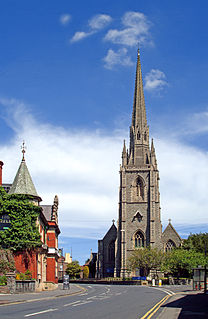
Stapleton is an area in the northeastern suburbs of the city of Bristol, England. The name is colloquially used today to describe the ribbon village along Bell Hill and Park Road in the Frome Valley. It borders Eastville to the South and Begbrook and Frenchay to the North. It comprises an eclectic mix of housing mainly from the Victorian, Edwardian, inter-war and late 20th century periods.
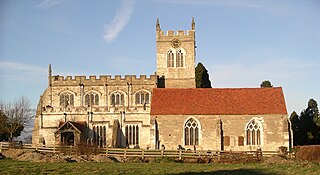
Wootton Wawen is a village and civil parish in the Stratford-on-Avon district of Warwickshire, England. The village is on the A3400, about 20 miles (32 km) from Birmingham, about 2 miles (3 km) south of Henley-in-Arden and about 6+1⁄2 miles (10 km) north of Stratford-upon-Avon. The soil is a strong clay and some arable crops are grown, but the land is mainly in pasture. The common fields were inclosed in 1776, but some inclosures had already been made about 1623.

The Collegiate Church of the Holy and Undivided Trinity, Stratford-upon-Avon is a Grade I listed parish church of the Church of England in Stratford-upon-Avon, Warwickshire, England. It is often known simply as Holy Trinity Church or as Shakespeare's Church, due to its fame as the place of baptism, marriage and burial of William Shakespeare. More than 200,000 tourists visit the church each year.

Great Alne is a small village in Warwickshire, England, 7 miles (11 km) north-west of Stratford-upon-Avon, 3 miles (4.8 km) north-east of Alcester, and 15 miles (24 km) from Warwick, on the road to Wootton Wawen. It takes its name from the River Alne and was first chronicled in the charter of King Ethelbald (723–737).
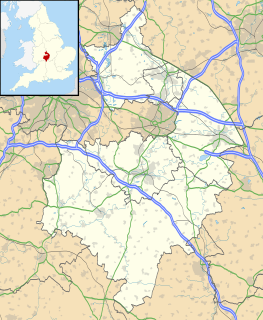
Binton is a village and civil parish in the Stratford district of Warwickshire, England. It is about five miles (8.0 km) west of Stratford-upon-Avon. According to the 2001 census it had a population of 272, increasing to 311 at the 2011 census.

Compton Verney is a parish and historic manor in the county of Warwickshire, England. The population taken at the 2011 census was 119. The surviving manor house is the Georgian mansion Compton Verney House.

Old Milverton is a hamlet east of Warwick and north west of Leamington Spa in Warwickshire, England, and situated in a bend of the River Avon. The population as taken at the 2011 census was 319.

Kinwarton is a village in the valley of the River Alne, Warwickshire, to the north east of the market town of Alcester. The population of the civil parish at the 2011 census was 1,082. The ground is mostly low-lying, with a maximum altitude of 206 ft. and some of the fields near the river are liable to floods. The road from Alcester to Henley-in-Arden runs through the middle of the parish. A branch road leads off to the church and rectory about a quarter of a mile to the south and thence continues as a field-path down to a ford across the Arrow below Hoo Mill. From the north side of the main road a by-road branches off to Coughton.
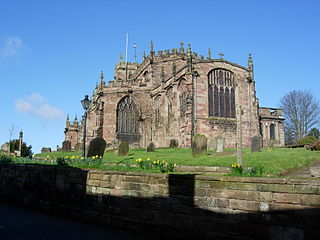
St Oswald's Church stands on the highest point in the market town of Malpas, Cheshire, England, on or near the site of a Norman motte and bailey castle. The church is recorded in the National Heritage List for England as a designated Grade I listed building and is recognised as being one of the best examples in Cheshire of a late 15th to early 16th-century church. It is an active Anglican parish church in the diocese of Chester, the archdeaconry of Chester and the deanery of Malpas. Its benefice is combined with those of St John, Threapwood, and Holy Trinity, Bickerton. Alec Clifton-Taylor includes it in his list of 'best' English parish churches.

Southminster is a town and electoral ward on the Dengie peninsula in the Maldon district of Essex in the East of England. It lies about 3 miles (4.8 km) north of Burnham-on-Crouch and 10 miles (16 km) south-east of Maldon; and approximately 52 miles (84 km) east-northeast of London. To the north is the River Blackwater, which is tidal and since Roman times has been the gateway to trading in the area.

Stivichall or Styvechale is a suburb of the city of Coventry, West Midlands, England. It is a mainly residential area in the south of the city.

Weston-on-Avon is a village in Warwickshire, England. The population of the Civil Parish taken at the 2011 census was 170. It is about 3 miles (5 km) south-west of the town of Stratford-upon-Avon.

St Mary's Church is an Anglican church at the end of a lane to the south of the village of Nether Alderley, Cheshire, England. It dates from the 14th century, with later additions and a major restoration in the late-19th century. The church is recorded in the National Heritage List for England as a designated Grade I listed building.

Oldberrow is a village in the Stratford on Avon District of Warwickshire, England. The parish was part of Worcestershire until 1896, when it was transferred to Warwickshire, into which county it penetrated, between Morton Bagot and Ullenhall, as a narrow strip some 3 miles (4.8 km) long by about ½ mile wide. Population details at the 2011 Census are still maintained under Redditch (Worcs). The land slopes from 513 ft (156 m) at Oldberrow Hill in the north-west to about 275 ft (84 m) in the south-east. There is no village, but the church, rectory, and the Court lie at the crossing of four small roads. It is now part of the parish of Morton Bagot, Oldberrow and Spernall which in 2001 had a population of 153.

Saint Chrysostom's Church is the Anglican parish church in Victoria Park, Manchester, England. The church is of the Anglo-Catholic tradition, and also has a strong tradition of being inclusive and welcoming.

All Saints Church is in the small village of Weston-on-Avon, Warwickshire, England. The church is recorded in the National Heritage List for England as a designated Grade I listed building. It is an active Anglican parish church in the diocese of Gloucester, the archdeaconry of Cheltenham and the deanery of Campden. Its benefice is combined with those of St Swithin's, Quinton and St Peter's, Welford.

Great Wolford is a village and civil parish at the bottom of a hill in the Stratford-on-Avon district of Warwickshire, England. With the neighbouring parish of Little Wolford it is part of 'The Wolfords'.

St Beuno's Church, Aberffraw is a 12th-century parish church in Anglesey, north Wales. A church was established in Aberffraw in the 7th century by St Beuno, who became the abbot of Clynnog Fawr, Gwynedd. St Beuno's may have been used as a royal chapel during the early Middle Ages, as the princes of Gwynedd had a court in Aberffraw. The oldest parts of the church date from the 12th century, although it was considerably enlarged in the 16th century when a second nave was built alongside the existing structure, with the wall in between replaced by an arcade of four arches. Restoration work in 1840 uncovered a 12th-century arch in the west wall, which may have been the original chancel arch or a doorway to a western tower that has been lost. The church also has a 13th-century font, some memorials from the 18th century, and two 18th-century copper collecting shovels.
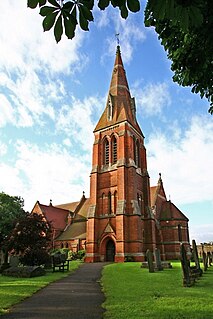
All Saints' Church, Winthorpe is a Grade II listed parish church in the Church of England in Winthorpe, Nottinghamshire, England. The current building, the construction of which was completed in 1888, is at least the third version of the church, which dates back to at least the early 13th century. All Saints' Church was commissioned by the church rector, Edward Handley, in memory of one of his relatives.

St Vincent's Church is a Grade I listed Church of England parish church in Caythorpe, Lincolnshire, England. It is at the southern edge of the Lincoln Cliff in South Kesteven, and 10 miles (16 km) north from Grantham.